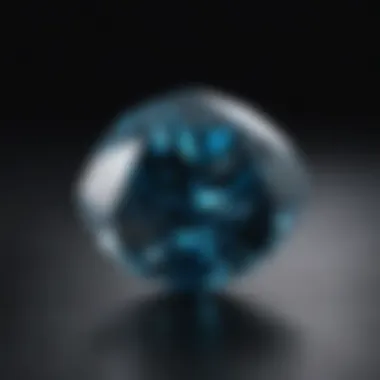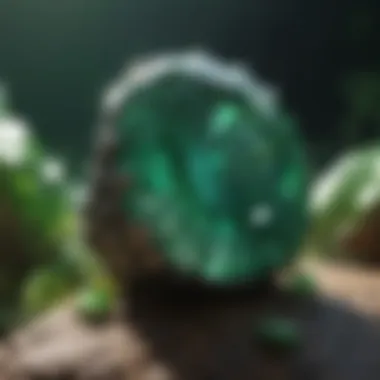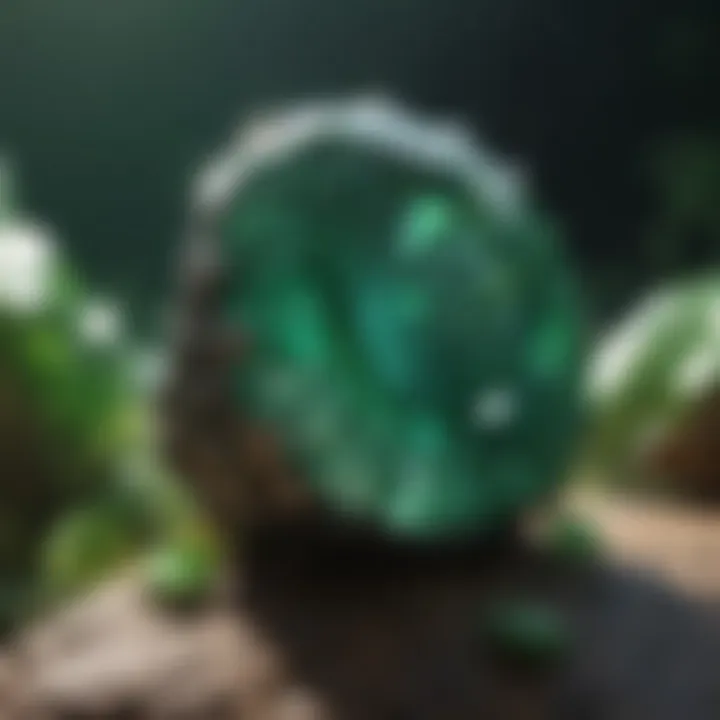Exploring Rare Gem Stones: A Comprehensive Guide


Intro
The world of rare gemstones captivates both collectors and enthusiasts. Each gemstone carries stories of formation, discovery, and value. This article explores essential aspects of rare gems, including their origins, types, and investment potential. By understanding these elements, one can appreciate the importance of these geological wonders.
History and Origins
Overview of Collectibles, Rocks, and Fossils
Rare gemstones have a rich history that is intertwined with collectibles and fossils. Collecting these treasures often begins with a fascination for their origins and the geological processes that formed them. Rare gems, unlike common stones, are formed under specific conditions, making them valuable. Many collectors seek them not only for aesthetic reasons but also for their historical significance.
Historical Significance and Cultural Impact
Throughout history, rare gemstones have been prized for their beauty and symbolism. They were used in religious artifacts, royalty's crowns, and jewelry. Many cultures regarded specific gems as possessing healing properties or as protective talismans. For instance, lapis lazuli was adored by ancient Egyptians, symbolizing the heavens. Over time, these stones have transcended cultures and eras, becoming part of global heritage.
Identification and Classification
Guide to Identifying Rocks and Fossils
Identifying rare gemstones requires understanding their unique characteristics. Factors like color, clarity, cut, and carat weight play essential roles in this process. Tools such as magnifying lenses and hardness tests help to determine a gem's quality. Additionally, many enthusiasts refer to guides that delineate common features.
Common Types and Variations
Rare gemstones come in various types and variations. Some of the most recognized include:
- Alexandrite: Known for its color-changing properties.
- Tanzanite: Valued for its striking blue-violet hues.
- Benitoite: Rarely found, it’s known for its distinct blue color.
- Painite: Once considered the rarest mineral, its scarcity adds to its allure.
These gems not only attract interest for their beauty but also for their intricate formations and the stories behind their discovery. Each gem has a unique journey that enhances its value in both geology and commerce.
"Gemstones are not just materials; they are fragments of Earth’s history, telling tales of time, pressure, and beauty."
As we delve deeper into rare gemstones, it becomes clear that understanding their origins, identification, and cultural significance enriches the collecting experience.
Understanding Rare Gem Stones
Understanding rare gem stones is essential for anyone diving into the world of geology, collecting, or even jewelry-making. These stones are not just beautiful objects; they encapsulate unique qualities that speak to their origins, rarity, and value in various markets.
Definition and Characteristics
Rare gem stones are defined by their scarcity and exceptional beauty. They represent a finite resource, shaped by geological processes over millions of years. A gem stone’s characteristics include clarity, color, cut, and carat weight. Clarity refers to the presence of inclusions, which can impact the stone’s allure and value. The colors can range significantly, showcasing vibrant hues that often depend on the chemical composition of the mineral.
For instance, a stone like Alexandrite exhibits color change, appearing green in daylight and red under incandescent light. This phenomenon makes it highly sought-after. Another example is the Black Opal, which contains a play of colors due to its unique structure. Such characteristics not only enhance aesthetic appeal but also play a crucial role in determining a stone's market value.
Importance in the Natural World
The significance of rare gem stones extends beyond human fascination. In the natural world, these stones are considered indicators of geological processes and conditions. Their formation tells a story about the earth’s history, the environments in which they formed, and the conditions that made their existence possible. Furthermore, rare gems can also highlight the ecological systems surrounding them, as certain minerals and elements influence where and how they are found.
"Each rare gem stone is a time capsule, preserving the stories of the Earth beneath our feet."
Understanding these connections allows collectors and enthusiasts to appreciate the intrinsic value of rare gem stones. They are not merely commodities; they embody the earth's natural history and beauty, serving as a reminder of both the planet's complexity and the delicate balance of its ecosystems.
Rare gem stones also play a role in local economies and cultures. In some regions, they create jobs in mining and crafting, and they have significant cultural and spiritual meanings. Collectors should recognize this impact as they engage in the market.
In summary, embracing the concept of rare gem stones requires an appreciation of their definitions, characteristics, and broader significance in nature. This understanding enriches the experience of collecting and engaging with these fascinating geological treasures.
Types of Rare Gem Stones
In the realm of geology and gemology, understanding the different classificatons is vital. Rare gem stones can be broadly categorized into three groups: precious gems, semi-precious gems, and bespoke or unique stones. Each category carries its specific attributes, market demand, and personal appeal for collectors and enthusiasts. Grasping the distinctions among these types helps in making informed decisions about collecting, investing, and appreciating these geological wonders.
Precious Gems
Precious gems are the elite within the gem world, known for their exceptional beauty and durability. Diamonds, rubies, sapphires, and emeralds are the quintessential examples of precious stones. Their rarity is often amplified by the difficulty of extraction, the quality of the gemstone, and their historical significance in various cultures.
- Diamonds are not only valued for their clarity and size but also for their symbolism of eternal love. The Four Cs—cut, color, clarity, and carat weight—play a significant role in determining their value.
- Rubies are prized for their rich red color, which is a result of chromium content. The most valuable rubies originate from Myanmar, known for their "pigeon’s blood" hue.
- Sapphires come in various colors, although blue is the most recognized. Their strength makes them worthy options for daily wear.
- Emeralds are loved for their deep green color and often include inclusions known as "jardin," which is seen as part of their character rather than a flaw.


Semi-Precious Gems
While labeled as semi-precious, these gems are far from being less significant. This category includes stones like amethyst, aquamarine, and peridot. Though these gems may not possess the same price tags as precious stones, their variety and beauty make them sought after.
- Amethyst, which ranges from light lavender to deep purple, is often used in jewelry and is associated with clarity of mind.
- Aquamarine is another popular choice, characterized by its serene blue color. It is derived from beryl, the same mineral as emerald.
- Peridot is a vibrant green gem known for its unique color, attributed to iron and its volcanic origins.
The term semi-precious can be misleading. Many of these gems are rarer than some precious stones. It is essential to consider the individual character of each gem rather than the label.
Bespoke and Unique Stones
Bespoke or unique stones include gems that do not fall into the predefined categories of precious or semi-precious. These stones are often custom cut, making them highly valued among collectors and connoisseurs. Examples include rare varieties of garnet or tourmaline, stones like tanzanite, and even rare finds like benitoite.
- Tanzanite is noted for its vivid blue-violet colors and is found exclusively in Tanzania. Its limited location increases its rarity.
- Benitoite is celebrated for its striking blue color and is known as California's state gem. Its unique crystal structure and scarcity have created a niche market.
Factors Affecting Rarity
Understanding the rarity of gem stones connects directly to their appeal for collectors and investors. Rarity is not merely about price; it encompasses unique qualities, geological attributes, and market dynamics. Each element provides insight into why certain stones captivate attention and others remain obscure.
Geological Formation
The geological formation of gem stones holds significant relevance in determining their rarity. Most rare gems form under specific conditions, such as extreme pressure or particular chemical environments. For example, Alexandrite forms from chrysoberyl, where chromium gives it the unique color change effect. This specific formation process takes place over millions of years. As such, only a few sources can yield these stones, making them scarce.
Gemstones may also form in locations that are geographically unique. For instance, Painite was first discovered in Myanmar, and its formation is linked to the specific geological processes of that region. This rarity linked to formation heightens its desirability in the market, defining its status as one of the rarest minerals on Earth. Collectors often seek stones from particular locations that are known to yield extraordinary examples, thereby enhancing both their value and significance.
Location and Source
Location plays a crucial role in the rarity of gem stones. Areas rich in specific geological conditions often become sources for particular stones. While some gem stones are found in various regions, others are confined to unique localities. For example, Red Beryl is primarily found in just a few sites in Utah. The narrow geographic range significantly limits its availability and increases its rarity.
Additionally, political and environmental factors also affect accessibility to these sources. Countries experiencing conflict or stringent mining regulations might restrict access to gem stones, raising their rarity. Conversely, an abundant supply might dilute value, regardless of the gem's inherent characteristics. Therefore, collectors must pay close attention to the environmental and socio-political conditions surrounding gem sources as these factors directly influence market demand.
Market Demand
Market demand represents another fundamental factor influencing the rarity of gem stones. The desirability of a stone can shift based on current trends, celebrity endorsements, or advancements in marketing strategies. Societal shifts also impact demand; for example, rare stones with vibrant colors or unique features often create a buzz that drives collectors to seek them out.
Additionally, economic conditions can dictate how collectors perceive value. In times of economic stability, investment in luxury items—including rare gem stones—often increases. This heightened interest feeds into the cycle of demand, wherein the rarer a stone is, the more valuable it becomes to investors.
The intersection of geological uniqueness, limited sources, and market trends creates a complex web that dictates rarity in the gem stone industry.
Notable Rare Gem Stones
In the world of rare gem stones, certain varieties stand out not just for their beauty, but also for their unique characteristics and historical significance. Understanding these notable stones enhances the appreciation for the complexities involved in their formation and value in the market. Collectors often seek these gems due to their scarcity and the stories they carry. Below, we will delve into some of the most engaging examples of rare gem stones.
Alexandrite
Alexandrite is a unique gemstone that is known for its remarkable color-changing properties. Under different lighting conditions, it can appear either green or red, which makes it particularly sought after among gem enthusiasts. Discovered in the Ural Mountains of Russia in the 1830s, it was named after Tsar Alexander II. The rarity of high-quality Alexandrite primarily comes from its limited sources. Today, fine examples are primarily found in Brazil and Sri Lanka. Its unique optical effect is known as "thermal dichroism," which distinguishes it from many other gems.
Painite
Painite is often regarded as one of the rarest mineral specimens on Earth. Discovered in Myanmar in the 1950s, this stone was largely ignored until the late 2000s, when it gained attention as a collector's item. What sets Painite apart is its unique composition, featuring boron, aluminum, and oxygen. A small number of specimens exist, making it incredibly valuable. Its deep brownish-red hue can be exceptionally striking, drawing various collectors who appreciate its scientific and aesthetic qualities.
Red Beryl
Red Beryl, also known as Bixbite, is a striking gem that occurs very rarely in nature. Found primarily in the Wah Wah Mountains of Utah, it is often confused with Ruby due to its vivid red color. However, the chemical composition differs—Red Beryl is a beryllium aluminum silicate, whereas Rubies are a variety of corundum. The high level of transparency and exceptional clarity make Red Beryl coveted among gem collectors. Due to its scarcity, the gem can be significantly more expensive than Rubies.
Black Opal
Black Opal is distinguished for its rich body tone and vibrant play of color. Unlike traditional opals that can appear white or translucent, Black Opal has a darker hue that enhances the visibility of its chromatic display. The most well-known source of Black Opal is Lightning Ridge in Australia, which is famous for producing some of the world's most stunning examples. The gem is characterized by its unique patterns and color play, which can include reds, greens, and blues. Its rarity and mesmerizing appearance make it a prized possession in any gemstone collection.
"The allure of rare gem stones lies not just in their physical beauty but in the stories they tell about their origins and the earth's geological history."
Numerous factors affect the desirability of these gemstones. Collectors value these stones not solely for their beauty but for their rarity and historical context, which imbue them with a sense of significance. Understanding not only the aesthetic properties but also the geological narrative makes the experience of collecting even more enriching.
The Valuation of Rare Gem Stones
The valuation of rare gem stones is a critical aspect for collectors and enthusiasts alike. Understanding how these stones are valued helps in making informed decisions, whether for personal enjoyment or investment purposes. The rarity, quality, and provenance of a gem play significant roles in its market value. This section will explore various factors involved in valuation, including current market trends and the processes for appraisal and authentication.


Market Trends
The market trends for rare gem stones fluctuate based on various elements, affecting their value significantly. In recent years, there has been a noticeable increase in the demand for unique and rare stones due to growing awareness among collectors. High-value gemstones such as Painite or Black Opal have gained attention, and this increasing visibility can be linked to both social media and online forums where collectors share their experiences.
In addition, global economic conditions affect the market. For example, during periods of stability, collectors tend to invest more in rare gems, leading to increased prices. Conversely, economic uncertainty may deter investment, resulting in fluctuating values. Keep an eye on auctions and gem shows, as these events often set market prices that can influence buying choices.
"Staying updated on market trends is essential for serious collectors for making the best investment moves."
Appraisal and Authentication
Appraisal and authentication are vital for determining the true value of rare gem stones. An appraisal involves a professional assessment that establishes the quality and worth of a gemstone. Factors such as cut, clarity, color, and carat weight are carefully evaluated to provide a fair market price. It is advisable to seek appraisers who have certifications from recognized organizations, ensuring that an expert opinion backs the evaluation.
Authentication ensures that the gemstone is genuine. As the market for rare gems grows, so does the prevalence of counterfeit stones, making authentication increasingly important. Methods such as laboratory testing and certification from respected institutions like the Gemological Institute of America (GIA) help confirm a stone's identity and integrity. Knowing the difference between natural, synthetic, and treated stones is crucial for valuation.
In summary, understanding the valuation process of rare gem stones involves keeping pace with market trends, seeking expert appraisals, and ensuring proper authentication. Educating oneself about these aspects promotes smarter investments and appreciation of these extraordinary geological treasures.
Care and Maintenance of Rare Gem Stones
The significance of care and maintenance for rare gem stones cannot be overstated. Proper maintenance not only preserves their beauty but also prolongs their life and value. Rare gems often have unique properties that make them susceptible to damage if not handled correctly. Therefore, knowing how to clean and store these precious items is essential for any collector or enthusiast.
Cleaning Techniques
Cleaning rare gem stones is a task that requires careful consideration. Each type of gem has different characteristics that must be taken into account. For example:
- Soft stones like turquoise should be cleaned with a damp cloth, avoiding any harsh chemicals that could damage their surface.
- Harder gems such as diamonds can endure more vigorous cleaning methods, including ultrasonic cleaner. However, it is crucial to confirm that the gem can withstand this method.
- Avoid using steam cleaners as certain stones may have inclusions that can trap moisture, potentially leading to fractures.
In general, it is good practice to follow these steps when cleaning your rare gemstone:
- Examine the stone to understand its specific cleaning needs.
- Use a soft brush and mild soap for general dirt. This method is gentle enough for most stones while being effective in removing debris.
- Rinse thoroughly under lukewarm water to remove any soap residue.
- Dry gently with a soft cloth, avoiding any vigorous rubbing that can scratch the surface.
Proper maintenance extends beyond mere cleaning. It reflects a collector's commitment to preserving the unique features of rare gems.
Storage Recommendations
Storing rare gem stones requires careful organization and protective measures. The primary goal is to prevent scratches, chips, or any other damage that could occur during storage. Here are some useful tips:
- Individual pouches: Store each gem in a separate soft pouch made from microfiber or similar material. This minimizes direct contact with other stones, preventing scratches.
- Avoid sunlight exposure: Prolonged exposure to sunlight can fade the color of certain stones gradually. Keep them in a shaded area away from direct sunlight.
- Use a jewelry box: A designated jewelry box with padded compartments can provide safe storage. Ensure the box is made from materials that do not react negatively with gemstones.
- Maintain a controlled environment: High humidity or extreme temperatures can affect the quality of rare gem stones. Keep them in a cool, dry place with stable temperatures.
By implementing these cleaning techniques and storage recommendations, collectors and enthusiasts can ensure that their rare gem stones remain in excellent condition for future appreciation. Proper care is not only beneficial for the physical attributes of the stones but is also crucial for their lasting value.
Historical Context of Rare Gem Stones
The historical context of rare gem stones is imperative for understanding their evolution and significance in human culture. Throughout history, these stones have not only served as objects of beauty but also act as symbols of power, wealth, and spirituality. Their rarity and appeal have created a complex narrative involving trade, cultural beliefs, and evolving perceptions, which this section will explore in detail.
Cultural Significance
Rare gem stones have held significant cultural value across civilizations. Ancient cultures often attributed supernatural properties to certain gems. For instance, lapis lazuli was highly revered in ancient Egypt, symbolizing the heavens and used in burial artifacts. In various cultures, gemstones like ruby, emerald, and sapphire have been associated with royalty and prosperity. Collectors often seek these stones not just for their physical attributes but also for their mythical meanings and connections to the past.
Moreover, these stones are frequently used in religious rituals and artifacts. For instance, jade is particularly significant in Chinese culture, symbolizing purity and moral integrity. The presence of these stones in cultural artifacts speaks volumes about the societies that valued them and also aids in understanding historical trade practices.
Regularly, gemstones have been integrated into crowns, amulets, and ceremonial pieces, establishing their enduring prestige.
Historical Trade Routes
The trade of rare gem stones played a crucial role in shaping economies and fostering cultural exchanges across regions. Trade routes such as the Silk Road facilitated the movement of gemstones from East to West. Traders transporting stones would often embellish tales about their origins, enhancing their allure and value.
Understanding the historical trade routes reveals how these stones influenced economic practices and social interactions. The demand for rare gems led to the emergence of trading hubs, where gems were exchanged not just for currency, but also for goods and knowledge.
The historical importance of rare gemstone trade underlines the interconnectedness of ancient civilizations, setting the stage for modern commerce and valuation practices.
With the development of these trade networks, certain stones became symbols of wealth and status, impacting their valuation over centuries. Their emergence into European markets during various trade eras caused a significant shift in how these gems were perceived and valued in society.
The analysis of cultural significance and trade routes provides a comprehensive view of how rare gem stones have been integral to historical development, reflecting not just geological properties but also ongoing human narratives. Understanding this context enriches the knowledge of collectors and enthusiasts, fostering a deeper appreciation for these natural treasures.
The Future of Rare Gem Stones


The future of rare gem stones is a topic of increasing relevance, given the dynamic changes in both environmental considerations and market trends. As collectors and enthusiasts of these geological treasures, understanding the trajectory of rare gems becomes vital. This future encompasses sustainability, ethical sourcing, and the development of new markets.
Adopting an awareness of how these elements will shape the trading, collection, and valuation of rare gems helps inform decisions and collections today. Thus, exploring these topics can provide insight not only into the market but also into responsible practices that enhance the experience of collecting.
Sustainability and Ethics
Sustainability is becoming crucial in the gem stone industry. The environmental impacts of mining operations have prompted serious discussions about best practices. As awareness about climate change increases, gem enthusiasts are looking for alternatives that align with their values. Ethical sourcing of gem stones is essential. Buyers should consider the origins of their stones and the methods used to extract them.
Many organizations now provide certifications for ethically sourced stones, adding credibility to purchases. Collectors should prioritize gems from producers that follow regulations and maintain transparency in their supply chain.
- Consider the origin: Research the mining practices in the region where a stone is sourced. A responsible vendor will provide this information.
- Support ethical organizations: Look for gems certified by ethical bodies like the Responsible Jewelry Council.
- Select lab-created alternatives: These stones offer a sustainable choice and can be obtained without the environmental costs associated with traditional mining.
Incorporating mindfulness into gem stone acquisition reflects a commitment to sustainability.
Emerging Markets
Emerging markets for rare gems present both opportunities and challenges. Countries in Africa, Asia, and South America show promise as significant players in the global market. Countries such as Mozambique and Myanmar have gained visibility for their unique offerings, while others work to improve their regulatory frameworks for gem extraction. Collectors can benefit from these developments.
Investing in gems from newly established sources may yield high rewards, especially as global demand increases. However, collectors must navigate these markets with caution. Consider the following:
- Research local regulations: Understand the laws surrounding gem extraction to avoid supporting illegal operations.
- Stay updated on trends: Know which regions are becoming popular for certain gems. This can influence future value and desirability.
- Engage with local communities: Developing relationships with local sellers can offer insights into quality and ethical practices.
"The rarity of a gem stone is often defined by the intersection of supply availability and consumer demand."
The future of rare gem stones will likely reflect broader trends in sustainability and market explorations. Collectors who prioritize these factors stand poised to enhance their collections while supporting responsible practices.
Collecting Rare Gem Stones
Collecting rare gem stones is a pursuit that captivates many individuals, blending passion with knowledge. The act of gathering these natural wonders extends beyond mere ownership; it involves an appreciation for art, history, and the intricate processes that result in their formation. Collecting provides a channel for personal expression and can be a rewarding investment.
Understanding the importance of collecting rare gem stones enables enthusiasts to appreciate their value and significance. Each stone tells a story of geological history, showcasing unique characteristics shaped by the Earth's processes. Collectors gain insight not only into the stones themselves but also into the regions they originate from and the cultures that have revered them throughout history. This engagement fosters a deeper connection to the natural world and promotes conservation awareness.
Starting a Collection
Starting a collection may seem daunting at first, but it can be an exciting journey. It begins with defining your area of focus. Are you interested in specific types of stones, like alexandrite or painite, or do you want to explore bespoke options? Identify your criteria which can include aesthetics, rarity, or historical significance.
Once you have outlined your collecting goals, it's crucial to educate yourself. Research different gems and their unique properties. Resources such as libraries, specialized online forums, and workshops can provide valuable insights. Attend gem shows or exhibitions to interact with experts and immerse yourself in the community. Networking with knowledgeable individuals can amplify your understanding and help you make informed decisions.
"Knowledge empowers collectors to pursue their passions effectively, ensuring their collections are built on sound foundations."
Buying from reliable sources cannot be overstated. Look for reputable dealers or auction houses with a good track record. Authenticity and ethical sourcing should be prioritized. Consider investing in certificates of authenticity or appraisals when purchasing significant pieces.
As you grow your collection, keep detailed records of each piece. Document the stone's origin, characteristics, purchase details, and care instructions. Such records are not only useful for appreciation but also vital for future valuation and resale.
Joining Communities
Becoming part of gem-related communities can greatly enhance your experience as a collector. Online platforms, such as Reddit or Facebook groups, can connect you with fellow enthusiasts who share your interests. These communities often provide forums for discussion, advice, and even trade opportunities.
Local gem societies or clubs can offer face-to-face interactions. Workshops and meetings facilitate learning, possibly from guest speakers who are experienced gemologists or historians. Joining these groups fosters camaraderie and allows you to exchange ideas and tips with seasoned collectors.
Many online resources contain educational content, facilitating your growth in both passion and knowledge. Engaging in discussions can also aid in expanding your network of contacts and may lead to access to rare opportunities in the market.
The End
The conclusion of this article serves an essential purpose. It encapsulates the core insights about rare gem stones, emphasizing their importance not only in geological terms but also from historical, aesthetic, and investment perspectives. By summarizing the previous sections, we provide clarity and reinforce knowledge, paving the way for informed decisions regarding collection and acquisitions.
Recap of Key Points
Understanding rare gem stones requires recognizing several critical aspects:
- Definition and Importance: Rare gems possess distinct characteristics that contribute to their allure and value in nature.
- Types: Knowledge of precious, semi-precious, and bespoke gems helps in appreciating their uniqueness.
- Rarity Factors: Geological formation, source locations, and market demand play a significant role in determining rarity.
- Notable Examples: Familiarity with gems like Alexandrite, Painite, and Red Beryl enhances overall awareness.
- Valuation and Care: Appraisal methods and proper maintenance are crucial for preserving these valuable stones.
- Cultural and Historical Context: Recognizing the cultural significance and trade routes connects past practices with contemporary value.
- Future Considerations: Emphasis on sustainability addresses the ethical concerns around gem mining.
- Collecting: Insights into starting a collection and engaging with communities foster a deeper appreciation.
Final Thoughts
The exploration of rare gem stones offers both a scientific and sentimental journey, leading to a better understanding of their place in our world. Collectors benefit from this detailed examination, enhanced by a commitment to ethical practices and informed choices.
In summary, by approaching rare gem stones with thoroughness, one cultivates not just a collection, but a narrative that reflects both personal values and the broader cultural landscape. As they continue to bloom in popularity, a well-rounded knowledge equips collectors to navigate the complexities of this fascinating sphere effectively.
"Collecting rare gems is more than a hobby; it's a connection to history, beauty, and commerce, bridging the past and future in every facet."
For more information, visit resources such as Wikipedia or Britannica for in-depth historical context and geological studies.



